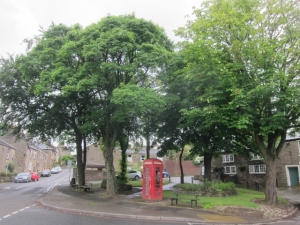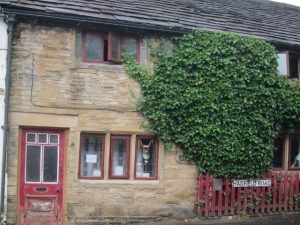1 The Domesday Book lists Hadfield as Hetfelt, the ‘King’s Land,’ around 4 bovates in size. Its

Hadfield, Derbyshire. The ‘new’ part of town
entry states, ‘The whole of Longdendale is waste. There is woodland, not for pasture but suitable for hunting.’ Longdendale’s value? 40 shillings (£2). Basically, William the Conqueror swiped the land for recreational purposes… A bovate, by the way, was an area of land equating to how much an ox could plough in one season which, depending on soil fertility, was between 15 and 20 acres.

Reputedly the oldest house in Hadfield
2 The oldest house (just opposite the Spinners Arms) is believed to have been a dairy farm in the 1720s.
3 This was before the advent of the cotton industry when Hadfield was a rural village like any other. The original village centre was on Hadfield road near the Spinners Arms which, in 1824, was an ale house

The old part of Hadfield, Derbyshire. The Spinners Arms is to the right.
4. In 1861, the Sisters of Charity settled in a small cottage in Hadfield Road moving in 1887 to a purpose built convent in the grounds of St Charles’ Borromeo Catholic Church. Veronica M Wright was the 47 year old ‘superioress’ in the 1891 census. A Norwich born school teacher, five more female teachers from Ireland, Essex, Oxford and Dorset lived there too. The visitor at the presbytery next door, (incorrectly spelled as prespetary by the enumerator) was Franciscan priest Bruno Knight from Peckham.

The Sisters of Mercy lived here 1861-1887
5 From the 1820s, the Sidebottom family invested in cotton mills and constructed a branch railway directly into their factories.
6 Hadfield Station, when it opened in 1844, was part of the Sheffield, Ashton under Lyne and Manchester Railway and subsequently the heart of the village moved nearer the station. Nowadays, Hadfield is the last stop on this line.
7 The 1871 and 1881 censuses record people born from as far away as Ireland. Cotton spinner John Doyle and his locally-born family all had mill working jobs in 1871.
8 By 1891, T & W Sidebottom owned the Bridge and Waterside Mills which, between them, had 293,000 spindles for yarn and 4,700 looms for weaving cloth,
9 The part of the railway which stretched from Hadfield to Sheffield (closed 1970) is now the Longdendale Trail for walkers and cyclists.
10 Some scenes for the BBC’s TV programme League of Gentleman were filmed in Hadfield.